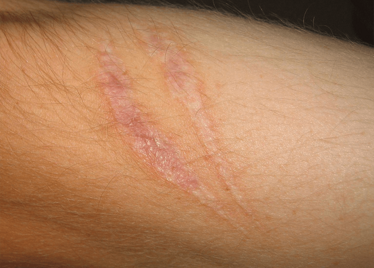
Psychologically, scars can act as a reminder of a painful or traumatic event. Physiologically, scar tissue exhibits compromised biomechanical properties when compared with uninjured skin (1). Reversing scarring – or preventing its formation in the first place – remains a desirable but elusive goal.
For a time, researchers worked on the principle that reducing or eliminating myofibroblasts would result in scarless wound healing – unfortunately to no avail. But a team of cross-institutional scientists have now discovered that myofibroblasts can transdifferentiate into adipocytes when hair follicles are present (2), which could mean that wound healing can be manipulated with scar-free results.
Various studies on wound healing in mouse models have found that hair follicles often regenerate at the site of large wounds. The new research delved into the process that leads to the generation of relatively normal skin in mice, and found that adipocytes around hair follicles were physiologically normal. The team hypothesized that hair follicles may be able to induce “ordinary” adipocytes and confirmed that hair follicles expressed the signaling molecules (for example, bone morphogenic protein, BMP) that trigger transdifferentiation of myofibroblasts into adipocytes in wound healing.
Keen to show that the findings are translatable into humans, the group also exposed human keloid fibroblasts (In culture conditions) to BMP and human hair follicles with similar results. Clearly translation of the findings into potential clinical approaches will demand further research and time, but the direct injection of signaling molecules and the development of cream formulations are both being considered (3). Interestingly, outside of wound healing, the researchers indicate that regeneration of fat cells could also pave the way for a new anti-aging treatment… But we’ll need to wait to see which comes first.
- DT Corr, DA Hart, “Biomechanics of scar tissue and uninjured skin”, Adv Wound Care (New Rochelle), 2, 37-43 (2013). PMID: 24527323.
- MV Plikus et al., “Regeneration of fat cells from myofibroblasts during wound healing”, Science, [Epub ahead of print] (2017). PMID: 28059714.
- UCI News, “UCI-Penn study in Science reveals natural processing for scar-free wound healing”, (2017). Available at: bit.ly/2j9fgZi. Accessed January 17, 2017.
My fascination with science, gaming, and writing led to my studying biology at university, while simultaneously working as an online games journalist. After university, I travelled across Europe, working on a novel and developing a game, before finding my way to Texere. As Associate Editor, I’m evolving my loves of science and writing, while continuing to pursue my passion for gaming and creative writing in a personal capacity.















